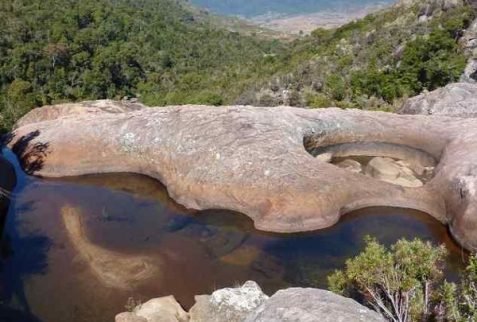Andringitra National Park: Madagascar’s Ultimate Mountain Escape
Declared a national park in 1993, Andringitra is one of Madagascar’s most stunning hiking destinations. This extraordinary mountain range stretches from north to south, forming a natural barrier that shapes both the landscape and the climate. With tropical rainforests, granite peaks, and valleys sculpted by time, it offers breathtaking views and an unmatched sense of adventure.
Towering at 2,658 meters, the park’s iconic Pic Boby (also known as Imarivolanitra) is Madagascar’s second highest summit—and a dream for seasoned trekkers. The ascent is challenging but deeply rewarding, revealing unique ecosystems along the way. The park is home to an astonishing variety of endemic flora and fauna, including rare orchids, ring-tailed lemurs, and chameleons found nowhere else on Earth.
There are two main access points:
-
Namoly Valley: Located 40 km east of Ambalavao (approx. 3–4 hours by car), this is the classic entry for high-mountain treks.
-
Tsaranoro Valley: About 70 km southeast of Ambalavao (2-hour drive), Tsaranoro is an epic starting point for a 3-day trek to Pic Boby, with dramatic cliffs and epic scenery.
As with any mountain region, the weather is unpredictable. Daytime temperatures can hit 25°C, then drop below freezing at night—the coldest temperatures in Madagascar are recorded here. Be prepared: pack warm layers, a quality sleeping bag, and sturdy hiking shoes.
Whether you’re into long treks, rock climbing, or simply want to immerse yourself in highland wilderness, Andringitra National Park delivers a raw, unforgettable experience far from the tourist trail.


Flora: A Living Garden in the Clouds
The Andringitra massif is a botanical treasure trove, with ecosystems that shift dramatically as you ascend. The landscape transitions through three major zones: tropical forest at lower altitudes, mountain rainforest, and finally high-altitude vegetation, where the air is thin and the flora becomes more compact and hardy.
Fittingly, “Andringitra” means “place of stunted plants”—a nod to the unique, dwarf-like vegetation found in its upper reaches. Here, trees grow smaller, leaves become tougher and more compact, and every plant seems to have adapted to survive the cold winds and fluctuating climate.
But don’t be fooled by the word “stunted”—this park bursts with plant life. Between the forested slopes and granite outcrops, you’ll find:
-
Over 100 species of orchids, many of which are endemic and bloom in unexpected bursts of color
-
Tree ferns that give parts of the forest a prehistoric vibe
-
Aloes and pachypodiums, sculptural and otherworldly, clinging to cliffs
-
Bamboos and palm trees, nestled into unexpected corners
-
Epiphytic plants (plants that grow on other plants) draped from trees like natural decorations
Andringitra’s plant life is a dream for nature lovers, photographers, and botanists alike. No two areas of the park look the same, and even seasoned hikers are often stunned by the sheer variety of textures, shapes, and greens.
Fauna: Madagascar’s Rare and Remarkable Residents
Andringitra is not just a feast for the eyes—it’s also alive with sound, movement, and some of the most biodiverse wildlife in the country. The park is a hotspot for endemic species, many of which are found only in this region and nowhere else on Earth.
Here’s a glimpse of who you might meet on the trails:
-
Over 100 species of birds including rare forest dwellers like the Pollen’s vanga, yellow-bellied sunbird-asity, and various ground-rollers
-
55 species of frogs, some brightly colored and many endemic to this specific ecosystem
-
More than 50 species of mammals, with 13 species of lemurs among them
Among the most iconic lemurs spotted in Andringitra:
-
Ring-tailed lemur (Lemur catta) – easily recognizable with its striped tail, often seen sunbathing on rocks
-
Golden bamboo lemur and greater bamboo lemur – shy and foliage-loving, these rare primates are prized sightings
-
Common brown lemur and red-bellied lemur – active and curious, usually found in the lower forest zones
-
Aye-aye – elusive and nocturnal, with its eerie long fingers and wide eyes, a sighting of this lemur is considered extremely lucky
Reptiles and invertebrates also thrive here, particularly in the humid lower forests—leaf-tailed geckos, tiny chameleons, and a variety of insects that seem pulled straight from a sci-fi movie.
Andringitra’s fauna is rich not only in numbers, but in evolutionary wonder. Much of what you see here has developed in complete isolation, and stepping into the park is like entering a living museum of biodiversity. Whether you’re into birds, lemurs, amphibians or plants, this park rewards the curious at every turn.
